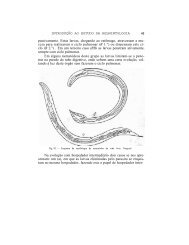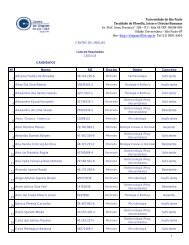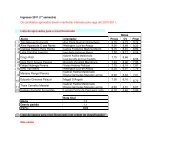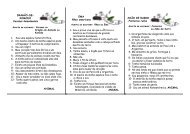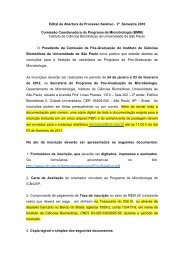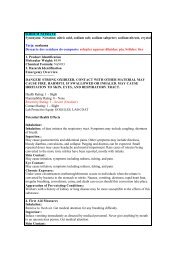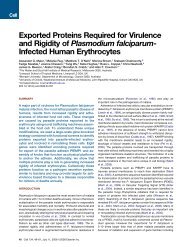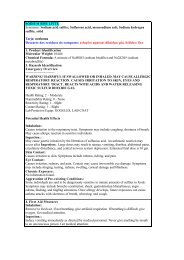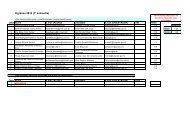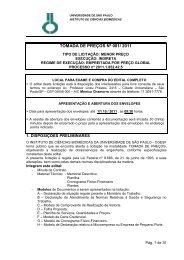SODIUM OXALATE Synonyms: Ethandioic acid disodium salt ... - USP
SODIUM OXALATE Synonyms: Ethandioic acid disodium salt ... - USP
SODIUM OXALATE Synonyms: Ethandioic acid disodium salt ... - USP
You also want an ePaper? Increase the reach of your titles
YUMPU automatically turns print PDFs into web optimized ePapers that Google loves.
<strong>SODIUM</strong> <strong>OXALATE</strong><strong>Synonyms</strong>: <strong>Ethandioic</strong> <strong>acid</strong> <strong>disodium</strong> <strong>salt</strong>; <strong>disodium</strong> <strong>salt</strong> oxalic <strong>acid</strong>Tarja: preta (produto tóxico)Descarte dos resíduos do composto: soluções aquosas diluídas: pia. Sólidos: incineração1. Product IdentificationMolecular Weight: 134.00Chemical Formula: NaOCOCOONa3. Hazards IdentificationEmergency OverviewPOISON! DANGER! CORROSIVE. CAUSES BURNS TO ANY AREA OF CONTACT.MAY BE FATAL IF SWALLOWED. HARMFUL IF INHALED. MAY AFFECTKIDNEYS.Health Rating: 3 - Severe (Poison)Flammability Rating: 0 - NoneReactivity Rating: 1 - SlightContact Rating: 3 - Severe (Corrosive)Lab Protective Equip: GOGGLES; LAB COAT; VENT HOOD; PROPER GLOVESPotential Health EffectsInhalation::Inhalation: of dust is corrosive to mucous membranes. Oxalates can be absorbed through thelungs. Symptoms of poisoning include nervousness, cramps, central nervous systemdepression.Ingestion::Mean lethal dose for oxalates in adults is estimated at 15-30 grams with death within a fewhours or even minutes. Corrosive action on the mucosa and severe gastrointestitis can occurwith pain, vomiting, etc. Sharp reduction of serum calcium can cause disfunction of the brain.Calcium oxalate may be deposited in the kidneys.Skin Contact:Corrosive. Symptoms of redness, pain, and severe burn can occur.Eye Contact:Corrosive. Contact can cause blurred vision, redness, pain and severe tissue burns.Chronic Exposure:Circulatory failure or nervous system irregularities may follow prolonged calcium metabolismdisturbances due to oxalatio n.Aggravation of Pre-existing Conditions:Persons with pre-existing skin disorders or eye problems, or impaired liver, kidney orrespiratory function may be more susceptible to the effects of the substance.4. First Aid MeasuresInhalation::Remove to fresh air. If not breathing, give artificial respiration. If breathing is difficult, giveoxygen. Get medical attention immediately.Ingestion::If swallowed, DO NOT INDUCE VOMITING. Give large quantities of water. Never giveanything by mouth to an unconscious person. Get medical attention immediately.
Skin Contact:Immediately flush skin with plenty of water for at least 15 minutes while removingcontaminated Clothing and shoes. Get medical attention immediately. Wash Clothing beforereuse. Thoroughly clean shoes before reuse.Eye Contact:Immediately flush eyes with plenty of water for at least 15 minutes, lifting lower and uppereyelids occasionally. Get medical attention immediately.5. Fire Fighting MeasuresFire:Not considered to be a fire hazard.Explosion:Not considered to be an explosion hazard.Fire Extinguishing Media:Use any means suitable for extinguishing surrounding fire.Special Information:In the event of a fire, wear full protective Clothing and NIOSH-approved self-containedbreathing apparatus with full facepiece operated in the pressure demand or other positivepressure mode.6. Accidental Release MeasuresVentilate area of leak or spill. Keep unnecessary and unprotected people away from area ofspill. Wear appropriate personal protective equipment as specified in Section 8. Spills: Pick upand place in a suitable container for reclamation or disposal, using a method that does notgenerate dust.7. Handling: and StorageKeep in a tightly closed container, stored in a cool, dry, ventilated area. Protect againstphysical damage. Isolate from incompatible substances. Containers of this material may behazardous when empty since they retain product residues (dust, solids); observe all warningsand precautions listed for the product.8. Exposure Controls/Personal ProtectionAirborne Exposure Limits:None established.Ventilation System:A system of local and/or general exhaust is recommended to keep employee exposures as lowas possible. Local exhaust ventilation is generally preferred because it can control theemissions of the contaminant at its source, preventing dispersion of it into the general workarea. Please refer to the ACGIH document, Industrial Ventilation, A Manual of RecommendedPractices, most recent edition, for details.Personal Respirators (NIOSH Approved):For conditions of use where exposure to dust or mist is apparent and engineering controls arenot feasible, a particulate respirator (NIOSH type N95 or better filters) may be worn. If oilparticles (e.g. lubricants, cutting fluids, glycerine, etc.) are present, use a NIOSH type R or Pfilter. For emergencies or instances where the exposure levels are not known, use a full-facepositive-pressure, air-supplied respirator. WARNING: Air-purifying Respirators do notprotect workers in oxygen-deficient atmospheres.Skin Protection:Wear protective gloves and clean body-covering Clothing.Eye Protection:
Use chemical safety goggles. Maintain eye wash fountain and quick-drench facilities in workarea.9. Physical and Chemical PropertiesAppearance: White powder.Odor: Odorless.Solubility: 3.7g/100g water @ 20C (68F).Specific Gravity: 2.34pH: Aqueous solution is neutral.% Volatiles by volume @ 21C (70F): 0Melting Point: 250 - 270C (482 - 518F)10. Stability and ReactivityStability:Stable under ordinary conditions of use and Storage.Hazardous Decomposition Products:May produce acrid smoke and irritating fumes when heated to decomposition.Hazardous Polymerization:Will not occur.Incompatibilities:Strong oxidizers and strong <strong>acid</strong>s.Conditions to Avoid:Heat, incompatibles.11. Toxicological InformationNo LD50/LC50 information found relating to normal routes of occupational exposure.



